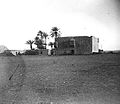Dhat al-Hajj
| Dhat al-Hajj | |
|---|---|
| Tabuk Province, Saudi Arabia | |
 The fort of Dhat al-Hajj, 1907 | |
| Coordinates | 29°02′50″N 36°10′09″E / 29.047272°N 36.169288°E |
| Length | 20 by 20 meters (66 ft × 66 ft) |
| Site information | |
| Controlled by | Saudi Arabia |
| Condition | Well-preserved |
| Site history | |
| Built | 1559 (completed 1563) |
| Built by | Suleiman the Magnificent |
| Materials | Stone, lime mortar |
Dhat al-Hajj is an archaeological site in the Tabuk Province of Saudi Arabia, located north of Tabuk and 16 kilometers (9.9 mi) south of the border with Jordan. Beginning sometime in the Middle Ages, Dhat al-Hajj served as a rest stop and watering place on the Hajj caravan route connecting Egypt and Syria to the Islamic holy cities of Mecca and Medina. The Ottomans fortified the site in the late 16th century. It fell into ruin by the early 18th century and was taken over by Bedouin tribesmen, though it was restored in later decades. The fort is a three-story square structure built around a courtyard and reservoir.
History
The earliest possible reference to Dhat al-Hajj was by the 9th-century geographer
The Ottoman Empire annexed the
In the early 19th century, John Burckhardt visited Dhat al-Hajj and remarked that it was surrounded by an abundance of fruitless date palms.[3] A formal inspection of the Dhat al-Hajj fort was carried out under the auspices of the Ottoman viceroy of Egypt, Muhammad Ali Pasha.[3] The report noted that the fort was in good condition and contained a cistern that was supplied with water by a spring within the fort's walls and via a canal by a spring located some distance from the fort.[3] Charles Doughty gave the first detailed European description of the fort in the late 19th century, during which he reported that the Hajj had "so much ... diminished from its ancient glory".[4] The Rubillat branch of the Banu Atiya tribe dominated the vicinity of Dhat al-Hajj at that time.[4]
Architecture
According to Petersen, Dhat al-Hajj "is one of the best preserved 16th-century forts on the Hajj route and despite several restorations ... the fort appears to be close to its original design."[4] The fort is a square, three-story structure that measures roughly 20 meters (66 ft) on each side.[4] The ground floor consists of a courtyard with a cistern.[4] The upper floor is a parapet indented at intervals for gun or arrow slits.[4] There are no window openings on the walls of the ground floor, but the second floor's walls have five narrow, arched openings on each side and the upper floor has two rows of openings on each side, with the upper row's openings wider than the bottom row.[4] On the corners nearest to the fort's gateway are two small, box-shaped latrines.[4] There are also three buttresses on each wall.[4] The fort was built with roughly-cut stone blocks set in white lime mortar.[4]
See also
References
Bibliography
- Petersen, Andrew (2012). The Medieval and Ottoman Hajj Route in Jordan: An Archaeological and Historical Study. Council for British Research in the Levant. ISBN 978-1842175026.



